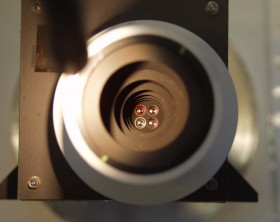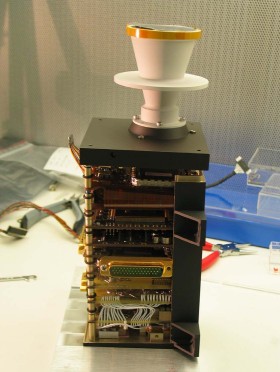Venus Monitoring Camera (VMC)
The Venus Express mission camera
 The Venus Monitoring Camera (VMC) is part of the Venus Express payload. One of the main goals of the Venus Express mission is to study the dynamics of the Venus atmosphere. This objective requires global imaging of the planet. The VMC is designed to meet this goal having a relatively wide field of view of 17.5°. The VMC will take images of Venus in four narrow band filters from UV to near-IR all sharing one CCD. The spatial resolution will be 0.2 km to 45 km per pixel, depending on the distance from the planet. The full disc of Venus will be in the VMC FOV near the apocentre of the orbit. The VMC will complement other instruments of Venus Express by
The Venus Monitoring Camera (VMC) is part of the Venus Express payload. One of the main goals of the Venus Express mission is to study the dynamics of the Venus atmosphere. This objective requires global imaging of the planet. The VMC is designed to meet this goal having a relatively wide field of view of 17.5°. The VMC will take images of Venus in four narrow band filters from UV to near-IR all sharing one CCD. The spatial resolution will be 0.2 km to 45 km per pixel, depending on the distance from the planet. The full disc of Venus will be in the VMC FOV near the apocentre of the orbit. The VMC will complement other instruments of Venus Express by
- tracking cloud motions at -70 km (cloud tops) and at -50 km (main cloud layer) altitude
- mapping O2 night-glow and its variability
- mapping the night side thermal emission from the surface and studying of the lapse rate and H2O content in the lower 6-10 km
In addition the VMC will provide imaging context for the whole mission and its movies of Venus atmosphere will be of significant interest for science as well as for the public outreach programme.
Science objectives
The VMC instrument using dedicated narrow angle filters and CCD detector with a sensitivity range from 0.3 to 1.0 µm will achieve the scientific goals
- Daytime observations in the UV-blue spectral range
- Observation of the visible airglow at the nightside
- Surface and lower atmosphere emission in the 1 µm transparency "window"
The main focus of this experiment will be to observe the dynamical phenomena in the Venus atmosphere in the altitude range from thermosphere (~150 km) to the main cloud deck (~50 km), as well as sounding of the surface through the 1 micron window.
![[Top]](/images/icons/top.gif)
Instrument description
 The VMC consists of one unit that houses the optics, CCD and readout electronics (CRE), digital processing unit (DPU), and the power converter (POC). A Peltier element connected to the bottom of the CCD will cool the detector.
The VMC consists of one unit that houses the optics, CCD and readout electronics (CRE), digital processing unit (DPU), and the power converter (POC). A Peltier element connected to the bottom of the CCD will cool the detector.
In order to avoid moving parts (filter wheel) the camera is designed so that four objectives (channels) share a single CCD. The stray light protection is provided by external and internal baffles. The VMC is be mounted on the +Y wall inside the spacecraft.
The image data from CCD are read out by CRE and sent to the 1 Gbit mass memory integrated within the DPU. This DPU is a so-called "system-on a chip" (SoC) approach, which integrates all DPU functions into a single chip and therefore results in a miniaturised implementation. The processor is based on a "LEON-2" SPARC V8 compatible core, implemented in a radiation hardened Xilinx Virtex FPGA. Before image data is sent to spacecraft via high speed IEEE 1355 interface, different image processing functions (e.g. flat-fielding or JPEG2000 compression) can be done real time or offline.
All VMC internal functions can be configured by the build-in "On-board Command Language" OCL, which allows the execution of user definable scripts in parallel working virtual machines.
![[Top]](/images/icons/top.gif)
Related links
 VMC Project Web Page
VMC Project Web Page
 VMC Documentation as PDF
VMC Documentation as PDF
